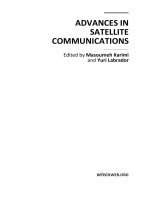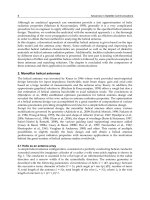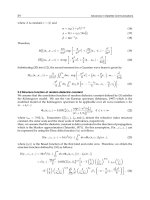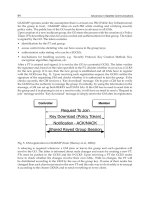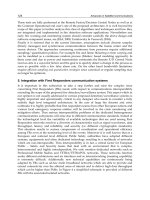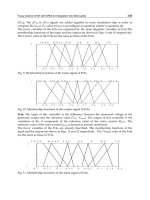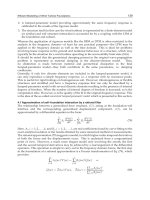Advanced Trends in Wireless Communications Part 1 pptx
Bạn đang xem bản rút gọn của tài liệu. Xem và tải ngay bản đầy đủ của tài liệu tại đây (465.05 KB, 35 trang )
ADVANCED TRENDS
IN WIRELESS
COMMUNICATIONS
Edited by Mutamed Kha b
Advanced Trends in Wireless Communications
Edited by Mutamed Khatib
Published by InTech
Janeza Trdine 9, 51000 Rijeka, Croatia
Copyright © 2011 InTech
All chapters are Open Access articles distributed under the Creative Commons
Non Commercial Share Alike Attribution 3.0 license, which permits to copy,
distribute, transmit, and adapt the work in any medium, so long as the original
work is properly cited. After this work has been published by InTech, authors
have the right to republish it, in whole or part, in any publication of which they
are the author, and to make other personal use of the work. Any republication,
referencing or personal use of the work must explicitly identify the original source.
Statements and opinions expressed in the chapters are these of the individual contributors
and not necessarily those of the editors or publisher. No responsibility is accepted
for the accuracy of information contained in the published articles. The publisher
assumes no responsibility for any damage or injury to persons or property arising out
of the use of any materials, instructions, methods or ideas contained in the book.
Publishing Process Manager Ivana Lorkovic
Technical Editor Teodora Smiljanic
Cover Designer Martina Sirotic
Image Copyright T-Design, 2010. Used under license from Shutterstock.com
First published February, 2011
Printed in India
A free online edition of this book is available at www.intechopen.com
Additional hard copies can be obtained from
Advanced Trends in Wireless Communications, Edited by Mutamed Khatib
p. cm.
ISBN 978-953-307-183-1
free online editions of InTech
Books and Journals can be found at
www.intechopen.com
Part 1
Chapter 1
Chapter 2
Chapter 3
Chapter 4
Part 2
Chapter 5
Chapter 6
Preface IX
Channel Characterization and Applications 1
An Overview of the Physical Insight and the Various
Performance Metrics of Fading Channels
in Wireless Communication Systems 3
K.P. Peppas, H.E. Nistazakis and G.S. Tombras
Indoor Channel Characterization and Performance
Analysis of a 60 GHz near Gigabit System
for WPAN Applications 23
Ghaïs El Zein, Gheorghe Zaharia,
Lahatra Rakotondrainibe and Yvan Kokar
Performance Analysis
of Maximal Ratio Diversity Receivers
over Generalized Fading Channels 47
Kostas Peppas
Humidity Measurements
using Commercial Microwave Links 65
Noam David, Pinhas Alpert and Hagit Messer
Antenna Design and Performance 79
Assessment of Indoor Propagation
and Antenna Performance
for Bluetooth Wireless Communication Links 81
Tommy Hult and Abbas Mohammed
Adaptive Antenna Arrays for Ad-Hoc
Millimetre-Wave Wireless Communications 93
Val Dyadyuk, Xiaojing Huang, Leigh Stokes,
Joseph Pathikulangara, Andrew R. Weily,
Nasiha Nikolic, John D. Bunton and Y. Jay Guo
Contents
Contents
VI
Network Coding and Design 117
Flexible Network Codes Design
for Cooperative Diversity 119
Michela Iezzi, Marco Di Renzo and Fabio Graziosi
Diversity and Decoding in Non-Ideal Conditions 143
(Chun-Ye) Susan Vasana
Block Transmission Systems
in Wireless Communications 159
Mutamed Khatib
Frequency Hopping Spread Spectrum:
An Effective Way to Improve
Wireless Communication Performance 187
Yang Liu
Multi-Input Multi-Output Models 203
Wireless Communication: Trend and Technical Issues
for MIMO-OFDM System 205
Yoon Hyun Kim, Bong Youl Cho and Jin Young Kim
Time Reversal Technique for Ultra Wide-band
and MIMO Communication Systems 223
Ijaz Naqvi and Ghaïs El Zein
Vehicular Systems 241
Connectivity Prediction in Mobile Vehicular
Environments Backed By Digital Maps 243
Robert Nagel and Stefan Morscher
Indoors Localization Using Mobile
Communications Radio Signal Strength 265
Luis Peneda, Abílio Azenha and Adriano Carvalho
Intermittent Connectivity
Wireless Communication Networks 281
Genaro Hernández-Valdez and Felipe A. Cruz-Pérez
Optical Communications 301
Trends of the Optical Wireless Communications 303
Juan-de-Dios Sánchez- López, Arturo Arvizu M,
Francisco J. Mendieta and Iván Nieto Hipólito
Part 3
Chapter 7
Chapter 8
Chapter 9
Chapter 10
Part 4
Chapter 11
Chapter 12
Part 5
Chapter 13
Chapter 14
Chapter 15
Part 6
Chapter 16
Contents
VII
Visible Light Communication 327
Chung Ghiu Lee
Non-mechanical Compact Optical Transceiver
for Optical Wireless Communications 339
Morio Toyoshima, Hideki Takenaka and Yoshihisa Takayama
Communication Protocols and Strategies 351
Efficient Medium Access Control Protocols
for Broadband Wireless Communications 353
Suvit Nakpeerayuth, Lunchakorn Wuttisittikulkij,
Pisit Vanichchanunt, Warakorn Srichavengsup, Norrarat
Wattanamongkhol, Robithoh Annur, Muhammad Saadi,
Kamalas Wannakong and Siwaruk Siwamogsatham
Wireless Communication-based Safety Alarm
Equipment for Trackside Worker 379
Jong-Gyu Hwang and Hyun-Jeong Jo
Wireless Communication Protocols
for Distributed Computing Environments 399
Romano Fantacci, Daniele Tarchi and Andrea Tassi
Resume and Starting-Over-Again Retransmission
Strategies in Cognitive Radio Networks 421
Sandra Lirio Castellanos-López, Felipe A. Cruz-Pérez
and Genaro Hernández-Valdez
System Fabrication 437
Fabrication and Characterizations of Multi-Layer Thin
Film Internal Antenna for Wireless Communication 439
Book-Sung Park, Hyun-Sang Lee and Soren Pedersen
Design of CMOS Integrated Q-enhanced
RF Filters for Multi-Band/Mode Wireless Applications 461
Gao Zhiqiang
High-frequency Millimeter Wave Absorber Composed
of a New Series of Iron Oxide Nanomagnets 493
Asuka Namai and Shin-ichi Ohkoshi
Trends and Challenges in CMOS Design
for Emerging 60 GHz WPAN Applications 505
Ahmed El Oualkadi
Chapter 17
Chapter 18
Part 7
Chapter 19
Chapter 20
Chapter 21
Chapter 22
Part 8
Chapter 23
Chapter 24
Chapter 25
Chapter 26
Pref ac e
Recently, mobile communication services are penetrating into our society at an ex-
plosive growth rate. All of the current communication systems have adopted digital
technology. Nowadays, the demand for various wideband services such as high-speed
Internet access and video/high-quality image transmission, is increasing. The third-
generation mobile communication system has been, designed to support wideband
services with the same quality as the fi xed networks. The wireless communication sys-
tems are expected to play a more important role in providing portable access to future
information services. The demand for new services to support Internet and advanced
video applications presents the key technical challenges, i.e., multimedia access re-
quires high-bandwidth and low-latency network connections for many users, mobility
requires adaptation to time varying channel conditions and portability imposes severe
constraints on receiver size and power consumption.
Physical limitations on wireless channels impose huge challenges on reliable com-
munication. Bandwidth limitations, propagation loss, noise and interference make the
wireless channel a narrow pipe that does not readily accommodate rapid fl ow of data.
Thus, researchers aim to design systems that are suitable to operate in such channels,
in order to have high performance quality of service. Also, the mobility of the commu-
nication systems requires further investigation to reduce the complexity and the power
consumption of the receiver.
This book presents new techniques that improve the performance of the communica-
tion system used for transmission of digital data over time varying channels such as
high frequency mobile channels. It aims to provide highlights of the current research
in the fi eld of wireless communication, and to off er a contribution to the recent advanc-
es in this fi eld. The subjects discussed in this work are very valuable to any researcher
in the communication fi eld not only to researchers in the wireless related areas. The
twenty-six chapters cover a wide range of topics in wireless communication starting
with the channel characterization, the conventional and adaptive antenna design, net-
works coding, optical communication, Multi-Input Multi-Output (MIMO) systems,
system fabrication and design, vehicular technologies, and communication protocols.
X
Preface
The editor would like to thank all of the authors for their valuable contributions in
the area of wireless communications hoping that the book will be of great help to the
readers.
February 2011
Dr. Mutamed Khatib
Department of Telecommunications and Technology
College of Engineering and Technology
Palestine Technical University – Kadoorie (PTU)
Tul Karm,
Palestine
Part 1
Channel Characterization and Applications
K.P. Peppas
1
, H.E. Nistazakis
2
and G.S. Tombras
3
1
National Center Of Scientific Research "Demokritos"
2,3
Department of Electronics, Computers, Telecommunications and Control,
Faculty of Physics
National and Kapodistrian University of Ath ens
Greece
1. Introduction
In this chapter, we discuss on the physical insight and the various performance metrics of
the wireless channels environment in today’s communications schemes. The availability
and reliability of such channels is closely related to the transmitted-received signal fading
conditions, a well known electromagnetic wave mitigation phenomenon due either to
multipath wave propagation or to shadowing from physical or man-made obstacles that
affect wave propagation. In this respect, we first examine the various types of fading that
the propagated signals may experience, being the multi-path induced or fast fading and the
shadow or slow fading, as well as flat fading and frequency selective fading. Then, we present
the methodologies that have been suggested for evaluating fading channels and rely on
different statistical distributions of the corresponding signal amplitude and phase variations.
Such distributions have been concluded from the study of the physical phenomena and laws
that govern wave propagation over different areas and under various conditions and most of
them have been experimentally studied. Following the above, we consider the most of the
main mathematical models that have been proposed and validated over time in describing
the fading channels characteristics and concentrate on three important performance metrics
being the average, or ergodic, capacity, the outage probability and the average bit error
probability. Finally, by considering each of those fading channel models, we discuss their
analytic convenience and accuracy with respect to the physical conditions implied.
2. Basic characteristics of fading channels
The propagation of energy in a mobile radio environment is characterized by various effects
including multi-path fading and shadowing. Such phenomena result in variations of the
channel strength over both time and frequency, thus impairing the performance of wireless
receivers. The above mentioned variations can be roughly classified into two categories:
• Large Scale Fading: This type of fading is due to path loss and shadowing. Path loss is
the attenuation of the electromagnetic wave radiated by the transmitter as it propagates
An Overview of the Physical Insight and the
Various Performance Metrics of Fading
Channels in Wireless Communication Systems
1
through space. It is noted that path loss is a major component in the analysis and design
of the link budget of a telecommunication system. Shadowing occurs where a large
obstacle between the transmitter and receiver obscures the main signal path between the
transmitter and the receiver. Such obstacles attenuate signal power through absorption,
reflection, scattering, and diffraction; when the attenuation is very strong, the signal is
blocked.
• Small Scale Fading: In a wireless communication environment, the propagation of energy
is characterized by waves that interact with physical obstacles via mechanisms such as
reflection, scattering, diffraction and absorption. This interaction, results in the generation
of a continuous distribution of partial waves (Braun & Dersch, 1991; Yacoub, 2007b). Each
wave experiences differences in attenuation, delay and phase shift in accordance with the
physical properties of the surface. The propagated signal arrives at the receiver through
multiple paths, resulting in a rapidly fading combined signal. This phenomenon can have
a constructive or destructive impact on the receiving signal, amplifying or attenuating the
signal power seen at the receiver. Small Scale Fading typically occurs over very short
distances, on the order of the carrier wavelength (Goldsmith, 2005).
Fading phenomena can also be classified to slow and fast fading. Such a classification is useful
for the mathematical modeling of fading channels as well as for the performance assessment
of communication systems operating over fading channels. The terms "slow" and "fast" refer
to the rate at which the magnitude and phase of the received signal varies with respect to the
channel changes. This classification is closely related to the coherence time T
c
of the channel.
The coherence time is a measure of the minimum time required for the magnitude change of
the channel to become uncorrelated from its previous value, or equivalently, the period of time
after which the correlation function of two samples of the channel response taken at the same
frequency but different time instants drops below a predefined threshold. The coherence time
is also related to the channel Doppler spread f
d
as
T
c
1/ f
d
.(1)
A wireless channel is called slow fading, when the coherence time of the channel, T
c
,islarge
relative to the delay requirement of a specific application. In slow fading, the amplitude and
phase change imposed by the channel can be considered roughly constant over the period
of use. On the other hand, fast fading occurs when the coherence time of the channel, T
c
is small relative to the delay requirement of the application (Simon & Alouini, 2005). In
fast fading, the amplitude and phase change imposed by the channel varies considerably
over the period of use. It should be noted that in a fast fading channel, coded symbols
can be transmitted over multiple fades of the channel while in slow fading they cannot.
Therefore, the characterization of a fading channel as slow or fast does not depend only on the
environment but also on the application and the demanding bit rate (Tse & Viswanath, 2005).
In practice, the characterization of a channel as fast or slow fading, depends strongly on the
bit rate of the link. More specifically, as data rates increase, wireless communication channels
become better described as slow fading. On the other hand, as the data rates decrease, the
channel is better described as a fast fading one (Belmonte & Kahn, 2009).
Frequency selectivity is another important characteristic of fading channels. In flat fading, the
coherence bandwidth of the channel is larger than the bandwidth of the signal. Therefore, all
spectral components of the transmitted signal will experience the same magnitude of fading.
This is the case for narrow-band systems, in which the transmitted signal bandwidth is much
smaller than the channel’s coherence bandwidth f
c
. The coherence bandwidth is defined
4
Advanced Trends in Wireless Communications
as the approximate maximum frequency interval over which two frequencies of a signal
are likely to experience correlated amplitude fading and measures the frequency range over
which the fading process is correlated. The coherence bandwidth is related to the maximum
delay spread τ
max
by
f
c
1/τ
max
(2)
On the other hand, in frequency selective fading the spectral components of the transmitted
signal are affected by different amplitude gains and phase shifts. This is the case
for wide-band systems in which the channel’s coherence bandwidth is smaller than the
transmitted signal bandwidth.
3. Statistical modeling of flat fading channels
Depending on the nature of the propagation environment, the statistics of the mobile radio
signal are well described by a great number of distributions available in the open technical
literature. The short-term signal variation is described by several distributions, such as the
Rayleigh, Rice (Nakagami-n), Nakagami-m, Hoyt (Nakagami-q), and Weibull distributions.
The derivation of these well-known fading distributions is based on the assumption of a
homogeneous diffuse scattering field, resulting from randomly distributed point scatterers.
The assumption is however an approximation since the surfaces are spatially correlated in
a realistic propagation environment (Braun & Dersch, 1991; Yacoub, 2007b). To address
such non-homogeneities of the propagation medium more generic distributions have been
proposed such as the generalized gamma, the κ-μ and the η-μ distributions.
Moreover, in addition to multi-path fading, the quality of the received signal is also affected by
shadowing. The statistics of the path gain due to shadowing can be appropriately described
by the log-normal distribution. In some environments, however, such as congested downtown
areas and land-mobile satellite systems with urban shadowing, the receiver should react to
the instantaneous composite multipath/shadow faded signal. In these cases, analysis of the
channel model must take into account both multi-path and shadow fading.
In this section, we present an overview of the most popular distributions used for statistical
fading models. Throughout this presentation, a narrow-band digital receiver is assumed. The
fading amplitude at the input of the receiver, R is a random variable (RV) with mean-square
value Ω
= ER
2
with E· denoting expectation. We also define the probability density
function (PDF) of R, f
R
(r) which depends on the nature of the propagation environment.
The equivalent baseband received signal can be expressed as z
= sR + n,wheres is the
transmitted symbol, and n is the additive white gaussian noise (AWGN) having one-sided
power spectral density N
0
Watts/Hz. Typically, n is assumed to be statistically independent
of R. The instantaneous signal-to-noise (SNR) per received symbol is γ
= R
2
E
s
/N
0
,where
E
s
= E|s|
2
is the energy per symbol. The corresponding average SNR per symbol is
γ = ΩE
s
/N
0
. Performing a simple RV transformation, the PDF of γ is obtained as
f
γ
(γ)=
f
R
Ωγ
γ
2
γγ
Ω
(3)
Finally, we define the moment generating function (MGF)
M
γ
(s) of γ as
M
γ
(s) Eexp(−sγ) =
∞
0
exp(−sγ) f
γ
(γ)dγ.(4)
5
An Overview of the Physical Insight and the
Various Performance Metrics of Fading Channels in Wireless Communication Systems
In the following, the most commonly used fading distributions will be presented with respect
to their PDFs and MGFs.
3.1 The Rayleigh fading model
The Rayleigh fading model agrees very well with experimental data when there are many
objects in the environment that scatter the radio signal before it arrives at the receiver. It
can also be applied to the propagation through the troposphere and ionosphere (Basu et al.,
1987; James & Wells, 1955; Sugar, 1955) and to ship-to-ship radio links (Staley et al., 1996).
According to the central limit theorem, if there is sufficiently much scatter, the channel impulse
response will be well-modelled as a zero mean complex Gaussian process. In this case, the
envelope of the channel impulse response will be Rayleigh distributed whereas the phase
uniformly distributed between 0 and 2π radians. The probability density function of the
channel fading amplitude R is given as
f
R
(r)=
2r
Ω
exp
−
r
2
Ω
, r
≥ 0. (5)
Using (3), the PDF of the equivalent instantaneous SNR per symbol, γ is given by
f
γ
(γ)=
1
γ
exp
−
γ
γ
, γ
≥ 0. (6)
As it can be observed, γ is exponentially distributed with parameter 1/
γ. Finally, the MGF of
γ is expressed in closed-form as follows
M
γ
(s)=
1
1 + sγ
.(7)
3.2 The Rice fading model
The Rice fading model, also known as the Nakagami-n fading model, arises when there
is a strong line-of-sight (LOS) component and many weaker components in the received
signal (Rice, 1948). This model is common in micro-cellular urban and suburban land-mobile
systems, pico-cellular indoor, satellite and ship-to-ship radio links (Bultitude et al., 1989;
Munro, 1963; Rappaport & McGillem, 1989; Shaft, 1974). The probability distribution for the
envelope of the received signal is given by:
f
R
(r)=
2(1 + n
2
)e
−n
2
r
Ω
exp
−
(
1 + n
2
)r
2
Ω
I
0
2nr
1 + n
2
Ω
, r
≥ 0(8)
where 0
≤ n < ∞ is the fading parameter and I
0
(·) is the modified Bessel function of the first
kind and zero order (Gradshteyn & Ryzhik, 2000b, Eq. (8.406) ). The quantity K
= n
2
is called
the Rice factor. Note that setting K
= 0 transforms this model into the Rayleigh fading model
and setting K
= ∞ would transform it into a simple AWGN model with no fading.
Using (3), the PDF of γ is given by
f
γ
(γ)=
(
1 + n
2
)e
−n
2
γ
exp
−
(
1 + n
2
)γ
γ
I
0
⎛
⎝
2n
(1 + n
2
)γ
γ
⎞
⎠
, γ
≥ 0. (9)
6
Advanced Trends in Wireless Communications
As it can be observed, γ follows a non-central chi-square distribution. Finally, the MGF of γ
is expressed in closed-form as follows
M
γ
(s)=
1 + n
2
1 + n
2
+ sγ
exp
−
n
2
sγ
1 + n
2
+ sγ
. (10)
3.3 The Hoyt fading model
The Hoyt fading model, also known as the Nakagami-q fading model (Hoyt, 1947), is common
in satellite links subject to strong ionospheric scintillation (Bischoff & Chytil, 1969; Chytil,
1967). The probability distribution for the envelope of the received signal is given by:
f
R
(r)=
r(1 + q
2
)
qΩ
exp
−
(
1 + q
2
)
2
r
2
4q
2
Ω
I
0
(1 − q
4
)r
2
4q
2
Ω
, r
≥ 0. (11)
where 0
≤ q ≤ 1 is the fading parameter.
The PDF of γ is given by
f
γ
(γ)=
(
1 + q
2
)
2qγ
exp
−
(
1 + q
2
)
2
γ
4q
2
γ
I
0
(1 − q
4
)γ
4q
2
γ
, γ
≥ 0. (12)
Moreover, the MGF of γ is expressed in closed form as
M
γ
(s)=
1
+ 2sγ +
(
2sγ)
2
q
2
(1 + q
2
)
2
−1/2
. (13)
3.4 The Weibull fading model
The Weibull fading, is a simple and flexible statistical model of fading used in wireless
communications and based on the Weibull distribution. Empirical studies have shown it to be
an effective model in both indoor and outdoor environments (Bertoni, 1988; Hashemi, 1993).
Furthermore, this model has recently gained significant interest in the field of performance
analysis of digital communications over fading channels (Karagiannidis et al., 2005; Sagias,
Karagiannidis & Tombras, 2004; Sagias, Karagiannidis, Zogas, Mathiopoulos & Tombras, 2004;
Sagias et al., 2003; Sagias & Tombras, 2007; Sagias, Zogas, Karagiannidis & Tombras, 2004;
Zogas et al., 2005). The Weibull PDF is given by
f
R
(r)=
β
(ΞΩ)
β/2
r
β−1
exp
−
r
2
ΞΩ
β/2
, r
≥ 0. (14)
where β
> 0 is the fading parameter and Ξ = 1/Γ(1 + 2/β),withΓ(·) being the Gamma
function (Gradshteyn & Ryzhik, 2000b, Eq. (8.310/1)). For β
= 2, (14) reduces to the Rayleigh
fading model. The corresponding SNR per symbol has PDF given by
f
γ
(γ)=
β
2(Ξγ)
β/2
γ
β/2−1
exp
−
γ
Ξγ
β/2
, γ
≥ 0. (15)
One can observe that γ also follows a Weibull distribution with parameter β/2. For β
> 0, the
MGF of γ is expressed in closed form as (Yilmaz & Alouini, 2009)
M
γ
(s)=H
1,1
1,1
1
Ξγs
(1,1)
(
1,2/β)
. (16)
7
An Overview of the Physical Insight and the
Various Performance Metrics of Fading Channels in Wireless Communication Systems
where H
m,n
p,q
(·) is the H-Fox function (Cook, 1981). A computer program in Mathematica
for the efficient implementation of the H-Fox function is given in (Yilmaz & Alouini, 2009,
Appendix A). For the special case of β
= 2l/k,wherel, k are positive integers with
GCD
(l, k)=1, the MGF can be expressed in terms of the more familiar Meijer-G function
as (Sagias & Karagiannidis, 2005)
M
γ
(s)=
β
2
1
(Ξγs)
β/2
l
β/2
√
k/l
(
√
2π)
k+l−2
G
k,l
l,k
l
l
/k
k
(Ξγs)
kβ/2
Δ(l;1−β/2)
Δ(k;0)
(17)
where G
m,n
p,q
(·) is the Meijer-G function (Prudnikov et al., 1986) and Δ(k; x)
{x/k, (x +
1)/k, ···, (x + k − 1)/k}. Note that the Meijer-G function is available in popular software
mathematical packages such as Maple or Mathematica. Moreover, from (Gradshteyn &
Ryzhik, 2000b), the Meijer-G function can be written in terms of the more familiar generalized
hypergeometric functions.
3.5 The Nakagami-m fading model
The Nakagami-m fading model is a purely empirical model and is not based on results
derived from physical consideration of radio propagation. It also often gives the best fit
to land-mobile and indoor-mobile propagation experimental data (Aulin, 1981; Braun &
Dersch, 1991). Moreover, is mathematically tractable because it leads to closed form analytical
expressions for important wireless communication systems performance metrics (Simon &
Alouini, 2005). The distribution of the received signal’s envelope is given by (Nakagami,
1960)
f
R
(r)=
2m
m
r
2m−1
Ω
m
Γ(m)
exp
−
mr
2
Ω
, r
≥ 0 (18)
where 1/2
≤ m ≤ ∞ is the fading parameter. parameter. For m = 1 the model reduces to the
Rayleigh fading model whereas for m
= 1/2 to the one sided gaussian distribution. The PDF
of the SNR per symbol, γ is distributed according to a gamma distribution given by
f
γ
(γ)=
m
m
γ
m−1
γ
m
Γ(m)
exp
−
mγ
γ
, γ
≥ 0 (19)
It can easily be shown that the MGF of γ is given by
M
γ
(s)=
1
+
sγ
m
−m
. (20)
3.6 Generalized fading models: The generalized-gamma, η-μ and κ-μ distributions
In many practical cases, situations are encountered for which no distributions seem to
adequately fit experimental data, though one or another may yield a moderate fitting. Some
researches (Stein, 1987) even question the use of the Nakagami-m distribution because its tail
does not seem to yield a good fitting to experimental data, better fitting being found around
the mean or median. Recently the so called generalized-gamma, η-μ and κ-μ distributions
have been proposed as alternative generic fading models. These distributions fit well
experimental data and include as special cases the well known distributions presented above.
8
Advanced Trends in Wireless Communications
3.6.1 The generalized-gamma distribution
The generalized-gamma fading model, also known as the α-μ (Yacoub, 2007a) or Stacy fading
model (Stacy, 1962), considers a signal composed of clusters of multi-path waves propagating
in a non-homogeneous environment. Within any one cluster, the phases of the scattered waves
are random and have similar delay times with delay-time spreads of different clusters being
relatively large. The resulting envelope is obtained as a non-linear function of the modulus
of the sum of the multipath components. The non-linearity is manifested in terms of a power
parameter β
> 0, such that the resulting signal intensity is obtained not simply as the modulus
of the sum of the multipath components, but as this modulus to a certain given power (Yacoub,
2007a). The PDF of the fading envelope is given by
f
R
(r)=
βr
mβ−1
(Ωτ)
mβ/2
Γ(m)
exp
−
r
2
Ωτ
β/2
, r
≥ 0. (21)
where β
> 0andm > 1/2 are parameters related to the fading severity and τ = Γ(m
i
)/Γ(m
i
+
2/β
i
). This distribution is very generic as it includes the Rayleigh model (β = 2, m = 1),the
Nakagami-m model
(β = 2) and the Weibull model (m = 1). Moreover, for the limiting case
(β = 0, m = ∞) it approaches the lognormal model. The PDF of the corresponding SNR is
given by
f
γ
(γ)=
βγ
m β/2−1
2 Γ
(
m
)
(
τ γ)
m β/2
exp
−
γ
τ γ
β/2
(22)
The MGF of γ is given by (Aalo et al., 2005; Yilmaz & Alouini, 2009)
M
γ
(s)=
1
Γ(m)
H
1,1
1,1
1
τγs
(1,1)
(
m,2/β)
. (23)
For the special case of β = 2l/k,wherel, k are positive integers with GCD(l, k)=1, the MGF
can be expressed in terms of the more familiar Meijer-G function as (Sagias & Mathiopoulos,
2005)
M
γ
(s)=
β
2Γ( m)
1
(τγs)
mβ/2
l
mβ/2
√
k/l
(
√
2π)
k+l−2
G
k,l
l,k
l
l
/k
k
(τγs )
kβ/2
Δ(l;1−βm/2)
Δ(k;0)
(24)
3.6.2 The η-μ distribution
The η-μ fading model is a generic fading distribution that provides an improved modeling of
small-scale variations of the fading signal in a non-line-of-sight condition. This model considers
a signal composed of clusters of multipath waves propagating in a non-homogeneous
environment. The phases of the scattered waves within any one cluster are random and they
have similar delay times. It is also assumed that the delay-time spreads of different clusters
are relatively large (Yacoub, 2007b). The η-μ distribution uses two parameters η and μ to
accurately model a variety of fading environments. More specifically, it comprises both Hoyt
(μ = 0.5) and Nakagami-m (η → 0, η → ∞, η →±1) distributions. Furthermore, it has
been shown that it can accurately approximate the sum of independent non-identical Hoyt
envelopes having arbitrary mean powers and arbitrary fading degrees (Filho & Yacoub, 2005).
The η-μ fading model appears in two different formats: In Format 1, the in-phase
and quadrature components of the fading signal within each cluster are assumed to be
independent from each other and to have different powers, with the parameter 0
< η < ∞
given by the ratio between them. In Format 2,
−1 < η < 1 denotes the correlation between
9
An Overview of the Physical Insight and the
Various Performance Metrics of Fading Channels in Wireless Communication Systems
the powers of the in-phase and quadrature scattered waves in each multi-path cluster. In both
formats, the parameter μ
> 0 denotes the number of multi-path clusters. The PDF of the
fading envelope R is given by
f
R
(r)=
4
√
πμ
μ+
1
2
h
μ
Γ(μ)H
μ−
1
2
r
ˆ
r
2μ
exp
−2μh
r
ˆ
r
2
I
μ−
1
2
2μH
r
ˆ
r
2
(25)
where
ˆ
r
=
√
Ω. The PDF of the corresponding average SNR per symbol γ is obtained as
f
γ
(γ)=
2
√
πμ
μ+
1
2
h
μ
Γ(μ)H
μ−
1
2
γ
μ−
1
2
γ
μ+
1
2
exp
−
2μγh
γ
I
μ−
1
2
2μHγ
γ
. (26)
In Format 1, h
=(2 + η
−1
+ η)/4 and H =(η
−1
−η)/4 whereas in Format 2, h = 1/(1 −η
2
)
and H = η/(1 −η
2
). Finally, the MGF of γ, with the help of (Ermolova, 2008, Eq. (6)), (Peppas,
Lazarakis et al., 2009, Eq. (2)) can be expressed as:
M
γ
(s)=(1 + As)
−μ
(1 + Bs)
−μ
(27)
where A
=
γ
2μ(h−H)
and B =
γ
2μ(h+H)
.
3.6.3 The κ-μ distribution
The κ-μ fading model is a generic fading distribution that provides an improved modeling
of small-scale variations of the fading signal in a line-of-sight condition. Similarly to the η-μ
case, this model considers a signal composed of clusters of multipath waves propagating in a
non-homogeneous environment. The phases of the scattered waves within any one cluster are
random and they have similar delay times. It is also assumed that the delay-time spreads of
different clusters are relatively large. The clusters of multipath waves are assumed to have
scattered waves with identical powers, but within each cluster a dominant component is
found (Yacoub, 2007b). As implied by its name, the κ-μ distribution uses two parameters
κ and μ to accurately model a variety of fading enviromnents. More specifically, it comprises
both Rice
(μ = 1) and Nakagami-m (κ → 0) distributions. The parameter κ is defined as
the ratio between the total power of the dominant components and the total power of the
scattered waves, whereas the parameter μ denotes the number of multipath clusters. The PDF
of the fading envelope R is given by
f
R
(r)=
2μ(1 + κ)
μ+1
2
κ
μ−1
2
exp(μκ)
r
ˆ
r
μ
exp
μ(1 + κ)
r
ˆ
r
μ
I
μ−1
2μ
κ(1 + κ)
r
ˆ
r
(28)
where
ˆ
r
=
√
Ω. The PDF of the corresponding average SNR per symbol, γ is easily obtained
as
f
γ
(γ)=
μ(1 + κ)
μ+1
2
κ
μ−1
2
exp(μκ)
γ
μ−1
2
γ
μ+1
2
exp
−
μ(1 + κ)γ
γ
I
μ−1
2μ
κ(1 + κ)γ
γ
(29)
Using (Ermolova, 2008) the MGF of γ is expressed in closed form as
M
γ
(s)=
(
1 + κ)
μ
μ
μ
[sγ +(1 + κ)μ]
μ
exp
−
μκγs
sγ + μ(1 + κ)
(30)
10
Advanced Trends in Wireless Communications
3.7 Log-normal shadowing
The link quality of practical wireless communication systems is also affected by slow variation
of the mean signal level due to shadowing. It is empirically confirmed that the log-normal
distribution can accurately model the variation in received power in both outdoor and indoor
radio propagation environments. The PDF of the instantaneous SNR per symbol γ is given by
f
γ
(γ)=
ξ
√
2πσγ
exp
−
(
10 log
10
γ − μ)
2
2σ
2
(31)
where ξ
= 10/ ln 10 = 4.3429, μ is the mean of 10 log
10
γ expressed in dB and σ is the standard
deviation of 10 log
10
γ, also in dB. The moment generating function of γ is given by
M
γ
(s)
1
√
π
N
∑
n=1
w
x
n
exp
10
(
√
2σx
n
+μ)/10
s
(32)
where x
n
are the zeros of the N-order Hermite polynomial and w
x
n
are the corresponding
weight factors given by (Abramovitz & Stegun, 1964). Finally, it should be noted that
the log-normal distribution is a very common and accurate model for wireless optical
communication systems under weak atmospheric turbulence conditions (Kamalakis et al.,
2006; Katsis et al., 2009; Laourine et al., 2007; Majumdar, 2005; Nistazakis, Tsiftsis & Tombras,
2009).
3.8 Generalized-K distribution
In a wireless propagation environment, multi-path fading and shadowing occur
simultaneously in many practical cases. Such cases often appear in congested downtown
areas with slow moving pedestrians and vehicles as well as in land-mobile satellite systems
subject to vegetative and/or urban shadowing (Simon & Alouini, 2005). By averaging the
signal power, which may follow one of the previously mentioned distributions, over the
conditional density of the log-normally distributed mean signal power, various distributions
may be obtained for modeling the composite environment, including the widely accepted
Rayleigh- and Nakagami-log-normal (Simon & Alouini, 2005). However, these fading models
are not widely used in the context of performance analysis of digital communication over
fading channels due to their rather complicated mathematical expressions. The use of
the gamma distribution as an alternative to the log-normal distribution, leads to other,
mathematically more tractable, composite distributions such as the generalized-K (K
G
)
distribution which is a mixture of a Nakagami-m and a gamma distribution (Bithas et al.,
2006; Peppas, 2009). Moreover, it has been proved that this alternative model has both
theoretical and experimental support (Abdi & Kaveh, 1999; 2000). Furthermore, the K
G
distribution includes the well known Double-Rayleigh model (Uysal, 2006). Therefore, it
can be further employed to model the power statistics in so-called cascaded multi-path
fading channels. Such channels occur in propagation through keyholes or in serial
relaying communications systems employing fixed gain relays (Peppas et al., 2010; Yilmaz
& Alouini, 2009). Consequently, the K
G
distribution can accurately capture the effects of
the combined multi-path fading and shadowing or cascaded multi-path fading, which are
both frequently encountered in wireless systems. The squared K
G
distribution, also known
as the gamma-gamma distribution in optical communications theory, has been recently
used in the performance analysis of free-space optical (FSO) communications systems over
atmospheric turbulence channels (Al-Habash et al., 2001; Bayaki et al., 2009; Uysal et al.,
2006). In FSO communications, the atmospheric turbulence results in rapid fluctuations at
11
An Overview of the Physical Insight and the
Various Performance Metrics of Fading Channels in Wireless Communication Systems
the received signal that severely degrade the optical link’s performance. The gamma-gamma
model in wireless optical communications theory is based on the assumption that small-scale
irradiance fluctuations are modulated by large-scale irradiance fluctuations of the propagating
wave, both modeled as independent gamma distributions. This distribution has become
the dominant fading channel model for FSO links due to its excellent agreement with
measurement data for a wide range of turbulence conditions (Al-Habash et al., 2001; Bayaki
et al., 2009).
A closed form expression for the K
G
PDF is obtained as follows: Let R be the instantaneous
amplitude of a flat fading channel with PDF modeled by the Nakagami-m distribution, i.e.
f
R|Y
(r)=
2m
m
r
2m−1
Y
m
Γ(m)
exp
−
mr
2
Y
, r
≥ 0 (33)
When multi-path fading is superimposed on shadowing, the parameter Y, randomly varies,
modeled in the following analysis with the gamma distribution. The PDF of Y is given by:
f
Y
(y)=
k
k
y
k−1
exp(−ky/Ω)
Γ(k)Ω
k
, y ≥ 0 (34)
where k is the shaping parameter and Ω
= EY. The PDF of the K
G
distribution, f
R
(r),is
obtained by averaging (33) over (34), i.e.
f
R
(r)=
∞
0
f
R|Y
(r|y) f
Y
(y)dy (35)
Using (Gradshteyn & Ryzhik, 2000b, Eq. (3.471/9)) the analytical expression for the PDF of
the corresponding fading envelope R is obtained as
f
R
(r|m, k, Ω)=
4Ψ
k+m
Γ(m)Γ (k)
r
k+m−1
K
k−m
(2Ψr), r ≥ 0 (36)
where K
a
(·) is the modified Bessel function of the second kind and order a and Ψ =
km
Ω
.For
k
→ ∞, (36) approximates the Nakagami-m distribution; for m = 1, it approximately models
Rayleigh-lognormal fading conditions (Bithas et al., 2006); while for m
→ ∞ and k → ∞,it
approaches the additive white Gaussian noise (AWGN) channel. The PDF of the average SNR
per symbol, γ is given by
f
γ
(γ)=
2Ξ
k+m
Γ(m)Γ (k)
γ
(
k+m
)
/2−1
K
k−m
(2Ξ
√
w) (37)
where Ξ
=
km
γ
.TheMGFofγ, can be obtained using (Bithas et al., 2006, Eq. (4)) as
M
γ
(s)=
Ξ
2
s
(k+m−1)/2
exp
Ξ
2
2 s
W
−(k+m −1)/2,(k−m)/2
Ξ
2
s
(38)
where W
λ,μ
(·) is the Whittaker function (Gradshteyn & Ryzhik, 2000a, Eq. (9.220)).
12
Advanced Trends in Wireless Communications
4. Performance metrics of fading channels
4.1 Channel capacity
The huge growth of the number of the mobile subscribers world-wide, during the last
decade, together with the increasing demand for higher information transmission rates and
flexible access to diverse services, has raised demand for spectral efficiency in wireless
communications systems. The pioneering work of Shannon established the significance of
channel capacity as the maximum rate of communication for which arbitrarily small error
probability can be achieved. Thus, the Shannon capacity provides a benchmark against which
the spectral efficiency of practical transmission strategies can be compared.
Of particular interest is the study of the Shannon capacity of fading channels under different
assumptions about transmitter and receiver channel knowledge. Shannon capacity results can
be used to compare the effectiveness of both adaptive and nonadaptive transmission strategies
in fading channels against their theoretical maximum performance. The main idea behind
these transmission schemes is balancing of the link budget in real time, through adaptive
variation of the transmitted power level, symbol rate constellation size, coding rate/scheme,
or any combination of these parameters (Alouini & Goldsmith, 1999). Such schemes can
provide a higher average spectral efficiency without sacrificing error rate performance. The
disadvantage of these adaptive techniques is that they require an accurate channel estimate
at the transmitter, additional hardware complexity to implement adaptive transmission, and
buffering/delay of the input data since the transmission rate varies with channel conditions
(Goldsmith & Varaiya, 1997).
Various works available in the open technical literature study the spectral efficiency of
adaptive transmission techniques over fading channels. Representative past works can be
found in (Alouini & Goldsmith, 1999; Laourine et al., 2008; Mallik et al., 2004; Peppas, 2010).
For example in (Alouini & Goldsmith, 1999), an extensive analysis of the Shannon capacity
of adaptive transmission techniques in conjunction with diversity combining over Rayleigh
fading channels has been presented. Moreover in (Mallik et al., 2004), by assuming maximum
ratio combining diversity (MRC) reception under correlated Rayleigh fading, closed-form
expressions for the single-user capacity were presented. Finally, in (Laourine et al., 2008) the
capacity of generalized-K fading channels under different adaptive transmission techniques
was studied in detail.
The adaptive transmission schemes under consideration are optimal simultaneous power
and rate adaptation (OPRA), optimal rate adaptation with constant transmit power (ORA),
channel inversion with fixed rate (CIFR) and truncated channel inversion with fixed rate
(TCIFR)(Biglieri et al., 1998; Goldsmith & Varaiya, 1997; Luo et al., 2003). The ORA scheme
achieves the ergodic capacity by using variable-rate transmission relative to the channel
conditions while the transmit power remains constant. The OPRA scheme also achieves
the ergodic capacity of the system by varying the rate and power relative to the channel
conditions, which, however, may not be appropriate for applications requiring a fixed rate.
Finally, the CIFR and TCIFR schemes achieve the outage capacity of the system, defined as
the maximum constant transmission rate that can be supported under all channel conditions
with some outage probability (Biglieri et al., 1998; Luo et al., 2003).
13
An Overview of the Physical Insight and the
Various Performance Metrics of Fading Channels in Wireless Communication Systems
